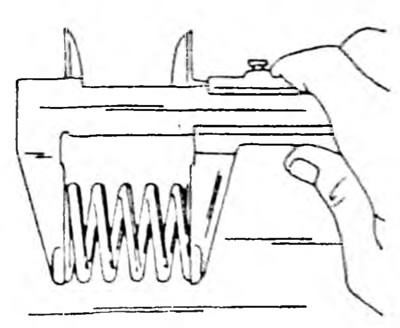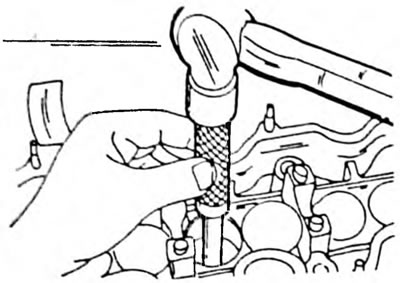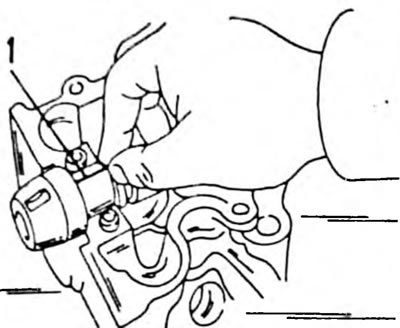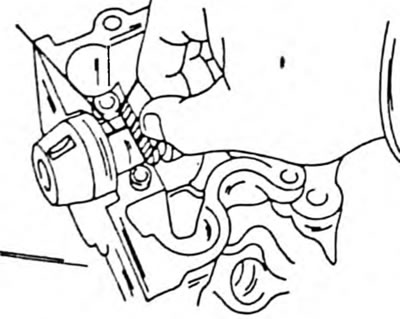Valve springs
To check the valve springs, a spring tester must be used. If this is not available, a used spring can be compared with a new spring. To do this, clamp both springs, located one behind the other, together in a vice and slowly tighten the vice. If both springs compress the same amount, this is a sign that they have approximately the same tension. But if the old spring compresses significantly more than the new one, then this is fatigue and the springs must be replaced as a set.
The free length of the spring can be measured with a caliper, as shown in Figure 302. Place the springs one by one on a smooth surface (glass plate) so that the closed turn is on the bottom side. Place a steel corner next to the spring. Measure the gap between the springs and the angle at the top (Pic. 46). The permissible size depends on the engine type. When the tolerance is exceeded, the spring is skewed.

Pic. 302. Measuring the length of the valve spring with a caliper
Valve guides
Clean the guides by dragging a rag soaked in gasoline through the guides. It is best to clean valve stems with a rotating wire brush, inserting it into the chuck of an electric drill and holding the valve stem close to it. Insert the valves one by one into the holes. To control the valve stem play in the holes, you must have a dial indicator and a caliper. The check has already been described for petrol engines, but on a diesel engine the inner diameter of the guide bushings should be between 8.01 and 8.03 mm. The valve stem diameter is 7.975-7.990 mm for intake valves and 7.960-7.975 mm for exhaust valves
Subtract the valve stem diameter from the inside diameter of the valve guides. The result is valve stem play in the bores, which should not exceed 0.10 mm for intake valves and 0.12 mm for exhaust valves.
Before replacing the guide bushing, the general condition of the cylinder head is checked. Cylinder heads with small cracks between the valve seats or between the valve seat and the first thread of the spark plug hole can be reinstalled and reworked, provided that the cracks are no wider than 0.5 mm. Also check the distortion of the cylinder head surface, which will be described below.
To replace the guide bushing, the old bushing must be knocked out with a drift from the top side of the cylinder head. Before knocking out the guides, follow these instructions:
- Using a depth gauge or straight edge, measure how much the guide bushing protrudes above the top surface of the cylinder head.
- Heat the cylinder head to 80-100°C and knock out the old guide bushing from the top side towards the combustion chamber. The drift must have a groove at the end that fits the inner diameter of the guide bushing. Using a dial indicator, measure the inner diameter of the intake hole in the cylinder head. If the size is between 13.000 mm -13.027 mm, a guide bushing with a nominal outside diameter size can be installed. If the diameter exceeds 13.027 mm, a guide bushing with an increased outer diameter must be installed. This means that the receiving holes for the guide bushings must be bored out in the workshop. Do not try to simply hammer bushings with an increased outer diameter into the holes. If you have experience with reaming, you can ream the holes to a diameter of 13.050-13.077 mm to install oversized guide bushings. If valve guides are replaced, the valves are also replaced and the valve seats must be ground in. Clean the inside surfaces of the receiving holes. Lubricate the new guides and drive them from the camshaft side into the cylinder head, heated to 90°C, so that the upper end protrudes above the upper surface of the cylinder head by the size measured before removing the old guides.
- After pressing, unscrew the valve guides using an 8 mm reamer. Intake valves should have a backlash of 0.02-0.055 mm; exhaust valves must have a backlash of 0.035 - 0.070 mm.
- After replacing the valve guides, the valve seats must be milled. If the seats can no longer be machined, there is no point in replacing the guides.

Pic. 303. Valve guide plugged
Valve seats
Check valve seats (see fig. 304) for absence of wear and cavities. Small signs of wear can be removed with a 45°cutter. However, if the seat is already worn out, the valve seats must be milled again. The specified angles are shown in Figure 304. However, a correction angle must be provided to correct the height of the valve seat chamfer, that is, a 30°cutter should be used (intake valves) or 60° (exhaust valves). As mentioned, valve seats can be milled clean if new valve guides are installed. First rout a 45°angle and then lightly use a 30 and 60 or 75°router bit on the top and bottom edge of the seat to reduce the width of the seat chamfer and bring it into the middle. The width of the working chamfer of the seat should be 1.2-1.6 mm for intake valves and 1.6-2.0 for exhaust valves. Finish the milling work as soon as the seat chamfer is within the tolerance width. Modified saddles should be worn in. To do this, apply abrasive paste to the surface of the valve seat and insert the valve into the corresponding seat. Place a suction cup on the valve and turn the valve in different directions (see also fig. 52). After grinding in, thoroughly clean all parts from paste and dirt and check the valve seat at the valve plate and seat chamfer. The continuous matte ring characterizes the width of the valve seat chamfer and should be visible on both parts. Draw a few lines on the "ring" on the valve disc. The strokes should be applied in a circle at a distance of 1 mm. After this, carefully lower the valve into the guide sleeve and seat and rotate the valve 90°with some pressure on the valve (use a suction cup). Remove the valve again and check whether the pencil marks have been removed from the chamfer. If the width of the valve seat chamfers is within the specified tolerances, the head can be reinstalled. Otherwise, process the valve seats or, in the worst case, replace the head.

Pic. 304. Valve seats. The top picture shows the intake valve seats, the bottom picture shows the exhaust valve seats. The width of the valve seat working chamfer is measured between both arrows.
Valves
The description of valves for gasoline engines also applies to valves for diesel engines. The valve disc edge size shown in Figure 53 should be 0.9 mm for inlet valves and 1.0 mm for exhaust valves. Otherwise, new valves must be installed. Valve measurements are made in accordance with the table of sizes and adjustments.
Cylinder head
Clean the contact surfaces of the cylinder head and cylinder block and check for misalignment of the cylinder head surface. To do this, I placed a measuring ruler on the head (Pic. 54) Using a set of feeler gauges, determine the clearance along, across and diagonally to the surface of the cylinder head. If a feeler gauge larger than 0.20 mm can be inserted, the cylinder head must be replaced. The same control should be carried out for the surface mating with the collector. Here too, a clearance of 0.20 mm is allowed.
Valve seats
The valve seats in the cylinder head can be replaced. Old seats are knocked out from the top side of the cylinder head into the combustion chamber. A compensation washer can be installed under the saddle. New seats should be driven in with a plastic hammer. In this case, the pin on the side of the seat and the notch in the cylinder head should be located on the same line. After installation, check how much the seats protrude above the contact surface of the cylinder head. To do this, install a dial indicator on the appropriate rack on a well-cleaned cylinder head and place the measuring probe on the surface of the cylinder head at the first seat to be measured. Set the indicator scale to zero. Now move the dipstick to the edge of the seat. The difference in readings should be between -0.03 mm and +0.03 mm. If that's not the case. Remove the seat again and place a compensation washer under it. There are a number of washers with a thickness from 0.05 to 0.10 mm, that is, based on the measurement result, it is easy to select the desired washer. Hammer the seat with the washer applied and repeat the measurement. All replacement saddles must be measured the same way.
Camshafts
Place the camshafts with the journals of both end bearings into the prisms or clamp them between the centers of the lathe, as shown in Figure 55, and install a dial indicator at one of the middle journals. Slowly rotate the camshaft and read the indicator readings. If the deviation of the arrow is more than 0.06 mm per revolution, the camshaft must be replaced, since it cannot be straightened. Next, check the bearing journals and camshaft surfaces for visible damage. If they are still in order, you should measure the height of the cams and the play of the bearings:
- To measure the height of the cams, use the micrometer shown in Figure 56. The specified dimensions and wear limits are given in the size and adjustment tables.
- Before checking bearing play, check for bearing metal peeling or cracking. If the covers are damaged, replace the covers, camshafts and cylinder heads.
- Clean the bearing caps and camshaft journals and arrange the caps according to the bearing numbers.
- Bearing play is measured using a PLASTIGAGE plastic hair. Apply a piece of this hair along the entire length of all trunnions (Pic. 305) and put on the lids one by one. Arrow I| All lids must be facing waterproof and the lid numbers must match.

Pic. 305. Apply a plastic strip (1) in the indicated direction onto the bearing journal
- Carefully knock down the covers and insert the bolts. Tighten the bolts from the middle outwards with a tightening torque of 18 Nm. After this, the distribution shaft cannot be rotated.
- Unscrew the bearing caps again and immediately check to see if there is a hair of PLASTIGAGE left on the cap. Otherwise, it also sticks to the bearing journal.
- Using the template supplied with the PLASTIGAGE, measure the width of the compressed plastic hair at its widest point (Pic. 306). It characterizes the minimum bearing play. If the play is greater than 0.10 mm, the cylinder head and/or camshaft must be replaced to bring the play within tolerance.

Pic. 306. Measuring the width of a crushed PLASTIGAGE hair to determine bearing play.
- To measure the axial play of the camshafts, clean the bearing holes in the cylinder head and bearing caps and install the camshaft in accordance with the above description. Tighten the bearing cap bolts in two or three passes.
- Install the dial indicator as shown in Figure 307 and move the camshaft in both directions, taking readings from the instrument. The resulting value is the axial play of the shaft, which should not exceed 0.25 mm. If there is more play, the camshaft should be replaced. Sometimes both parts are subject to wear.

Pic. 307. Measuring the axial play of the camshaft
Toothed belt and gears
A belt with broken teeth must definitely be replaced. Other defects include cracks, wear on the sides, or rounding of some or all of the teeth. In this case, the teeth of the gear wheels should also be checked. Hold the belt tensioner with one hand and turn the pulley with the other hand. Rubbing when turning the roller requires replacing the belt tensioner. The return spring of the tensioner must have a certain length. In this case, the length is measured between the inner sides of the spring hooks, as shown in Figure 205. If the spring becomes shorter than 51.93 mm, install a new spring.
Valve tappets
Measure the inner diameter of the holes for the pushers in the cylinder head and the outer diameter of the pushers. For this purpose, internal and ordinary micrometers must be available. The difference should be no more than 0.10 lams. Otherwise, the pushers must be replaced, and in the worst case, the cylinder head.
